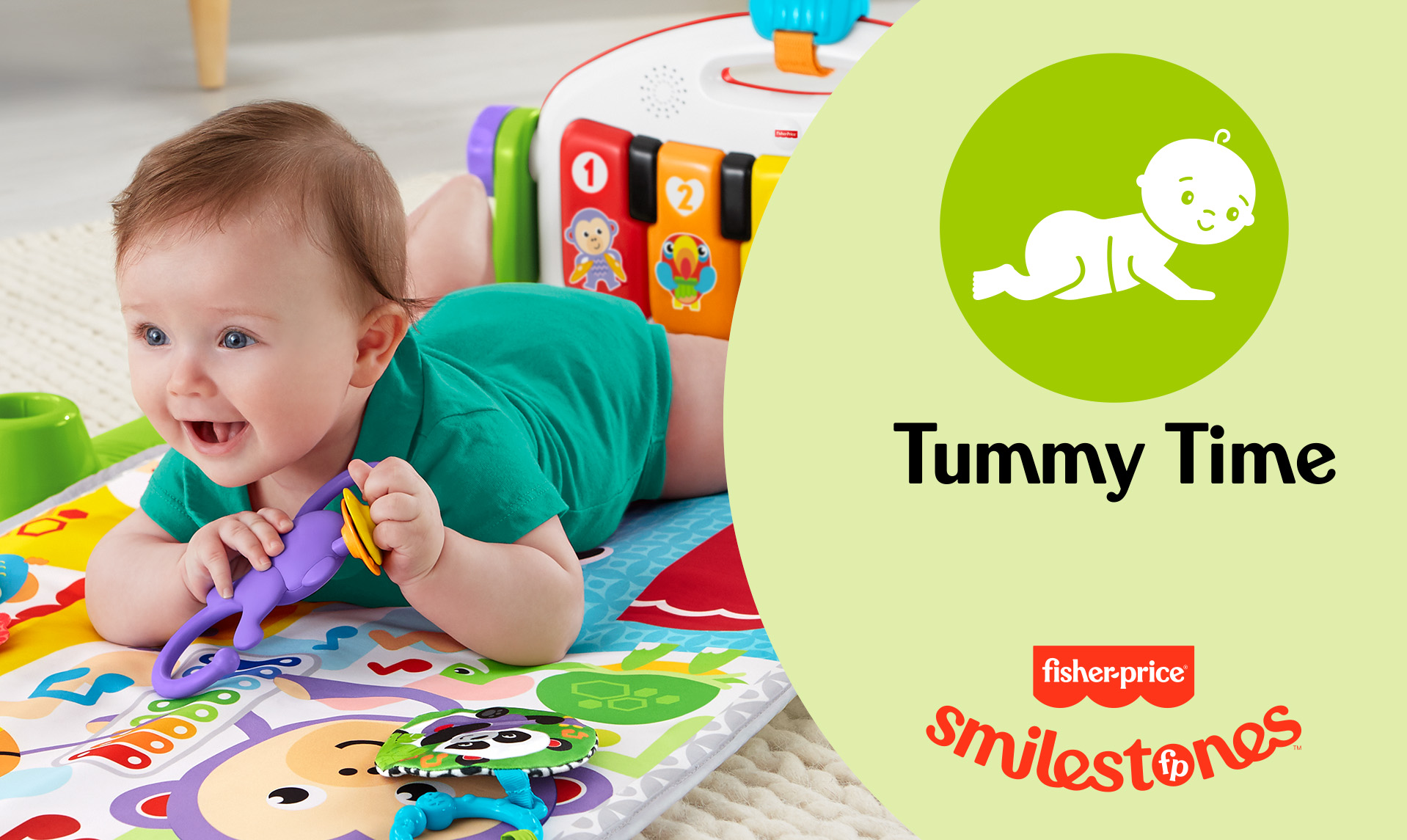When to Start Tummy Time: How to Help Your Baby Tackle Their First Workout
June 12, 2023

You’ve probably heard a lot about tummy time, and you probably still have tons of questions about this much-discussed baby activity. What is it? Why is it so important? When do you start tummy time and when do babies roll over? What if my baby hates it?
With everyone from health professionals to social media momfluencers talking up the activity, it might even feel like parenting “homework.” As an expert in play and development at the Fisher-Price Play Lab, I’m here to help you flip the script.
Tummy time and what it leads to, rolling over, are essential steps in your child’s physical development, but they don’t need to be a source of stress. Instead of seeing tummy time as one more task on your to-do list, we can make it just another part of playtime. So, don’t fear! I have answers to your questions and helpful tips so we can demystify this milestone and tackle tummy time together.

Why practice tummy time?
Tummy time is essentially your baby’s very first workout. It helps them build upper body strength, develop head control, and improve balance and coordination—all of which builds a foundation for your little one to eventually roll over, crawl and walk!
But there are more than physical benefits to the exercise. Tummy time can also:
- Promote brain development through mental stimulation
- Provide sensory benefits with fun toys and objects
- Give your baby a new vantage point to observe the world around them
When do you start tummy time?
It’s never too early to start working those baby muscles. You and your little one can begin tummy time on day one. How much time you spend depends on your baby’s age and developmental stage. You can follow these general guidelines:
- In months 0-3, start off small with just a few minutes of tummy practice each day. Stay close so you can support their neck—they may only be able to keep their head up for a short time.
- In months 3-6, try tummy time 2-3 times daily for a few minutes at a time. Gradually increase the length of tummy time as your baby grows and their neck and shoulders strengthen.
- In months 6 and up, your baby may use their new strength to spend even more time on their belly. Make sure your tummy time pro has plenty of space—they might try to push up and roll!
The best time of day for tummy play? After a nap, bath time or a fresh diaper change when your baby is calm and comfortable. A not so great time? Right after a meal. Laying on their tummy could interrupt their digestion and lead to some extra gas or spit up.

How to tackle tummy time with newborns: basic training
For new kids on the mat (or floor, or your belly), use these tactics to introduce tummy time to their daily play routine.

1. Practice tummy-to-tummy time.
It’s the same exercise, only cuddlier! Lay with your baby’s belly to your chest and talk or sing—this will encourage them to lift their head up. Make eye contact to keep them engaged.

2. Get down on their level.
Get on the floor with your baby and, once again, talk, sing and look into their eyes. Seeing you close by will make them feel more comfortable and motivated!

3. Put rewarding toys within reach.
Use toys that are high contrast (black, white and red are best for kids 0-3 months old), have interesting textures and make fun noises to encourage your baby to reach, grab and turn their head.

4. Plop them right in front of a mirror.
Who’s that other baby? Oh, it’s me! The mirror’s element of surprise and wonder will get your little one to lift up, look and, ideally, smile their cute little baby smile.

5. Give them a boost.
A tummy wedge will give your baby extra stability and help them lift their head. No wedge? Lay your baby in front of you and prop their forearms up on your leg. A comfy position for them means a less fussy baby for you!

6. Take it slow.
Do what’s right for your baby. If they seem uncomfortable, put them on their back or pick them up. If they show signs of fatigue, like yawning, turning away from toys or crying, then it’s time to try again another day—and that’s ok!
The next level: tips for when they’re ready to roll
Once your baby rocks at tummy play, it’s time to roll. Guide them through these more advanced exercises to get them pushing up and rolling over.


When do babies roll over?
If you’re wondering when babies start rolling over, I can’t give you an exact date (wouldn’t that be nice?!). Like every milestone, this is not a one-size-fits-all situation. However, there is a general timeline for when you can expect them to start showing off those physical skills.

0-3 months
- Lifts head
- Extends legs
- Briefly grasps objects

3-6 months
- Turns head in both directions
- Pushes chest up
- Holds head steady
- Rolls from tummy to back

6-9 months
- Rolls from back to belly
- Rolls in both directions
- Pushes up to pivot around on stomach

Next stop: crawling! When babies learn to push up on their forearms or hands and roll over, their little bodies are slowly building the strength to take it to the next level—moving around on their hands and knees.

Why is my baby struggling with tummy time?
Although tummy time can be fun, let’s be real: we’ve also seen tears, spit up, drool and head bonks when putting babies in this position. Why might your baby hate it? It’s truly a difficult exercise for them—pretty much all babies struggle with it.
Tummy time gets babies out of their comfort zones, resulting in temporary fuss. Keyword: temporary! You and your baby can succeed with practice, patience and help from the above tips.



Parent check-in
How’s tummy training going?
If you’re still feeling stressed about it, go easy on yourself. Once your little one masters rolling over, they won’t mind it as much. It’s just getting to that point that can feel hard!
I get it—I remember doing tummy time with my son. To say he didn’t like this activity is an understatement. Screaming, red face, you name it. But it got easier over time as he started to develop those muscles. And when he rolled from belly to back the first time and saw my face over his, his face lit up with pride and the sweetest gum-filled smile!
Gentle reminder: If you ever have concerns about your child’s development, trust your gut and reach out to your pediatrician.”

Bringing a smile to milestones.
Say hello to happier parenting. We’re here to help you celebrate the little victories, let go of expectations, and pick up more positivity. Because after more than 90 years of helping families, we’ve learned that development happens naturally when fun leads the way.
Learn More








































